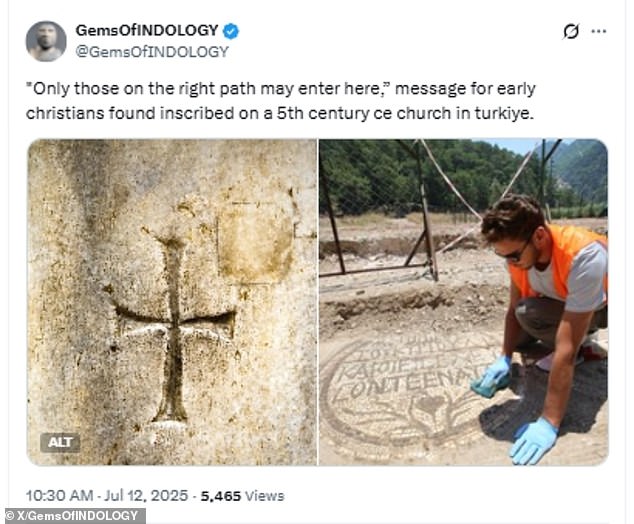[ad_1]
A message has been found sprawled out in front of a fifth-century church, left as a warning for all who dared to enter.
Archaeologists uncovered the ominous text while excavating Church No. 1 at the ancient city of Olympos, located in the Kumluca district of Antalya, Turkey.
The message, laid out as a stunning mosaic, reads: ‘Only those on the right path may enter here.’
The team said it was intended to direct the conduct of those entering the sacred space, and was meant to deter those who did not follow Christianity.
They have found other floor mosaics throughout the ruins of the church, featuring geometric shapes and botanical designs.
In addition to the church, archaeologists uncovered the remains of a civilian home built over what was once a Roman-era necropolis or burial ground.
During the Byzantine period, the area was likely repurposed due to population growth, with residential buildings replacing older tombs.
The home, also constructed in the fifth century AD, was later rebuilt after a fire in the sixth century.

The message, laid out as a stunning mosaic (right), reads: ‘Only those on the right path may enter here.’

Archaeologists uncovered the ominous text while excavating Church No. 1 at the ancient city of Olympos, located in the Kumluca district of Antalya, Turkey
It featured stone-paved floors and multiple rooms, and researchers found that the building’s original layout and function remained mostly intact during the reconstruction.
Gokcen Kutulus Oztaskin, associate professor at Pamukkale University and excavation director on the project, said: ‘These finds confirm Olympos as one of the richest ancient cities in the Lycia region in terms of mosaic flooring.
‘Olympos continues to surprise us with its rich mosaic heritage.’
The message was created using colored tiles laid out in the dirt, forming a circular shape.
‘A mosaic inscription placed directly at the church’s entrance reads, ‘Only those on the righteous path may enter here,” Öztaşkın added.
‘We also found mosaics bearing the names of the church’s benefactors.
Excavations at the site have been ongoing since 2006, and for the past four years, archaeological teams have continued work year-round without interruption.
‘Olympos is full of surprises. In 2017, 2022, and 2023, we uncovered richly decorated mosaic floors in various structures,’ Öztaşkın said.

To date, archaeologists have uncovered several important structures in Olympos, including Churches No. 1 and 3, the entrance complex, the Episcopal Palace, a bridge, the mausoleum of Lycian ruler Marcus Aurelius Arkhepolis, a mosaic-decorated building, the Antimachos Sarcophagus, and monumental harbor tombs

The excavation team is also continuing work on major monuments across the site, including the necropolis to the west, the city-center temple, the episcopal palace and Church No. 3
‘In 2024, we revealed the floor mosaics of Church No. 1, including an inscription right at the entrance.’
To date, archaeologists have uncovered several important structures in Olympus, including Churches No. 1 and 3, the entrance complex, the Episcopal Palace, a bridge, the mausoleum of Lycian ruler Marcus Aurelius Arkhepolis, a mosaic-decorated building, the Antimachos Sarcophagus, and monumental harbor tombs.
‘Our work at the site is still ongoing,’ said Öztaşkın. ‘We’ve preserved the building’s general structure, and we’re now preparing to explore what we believe may be a temple.
‘Toward the end of last year, we identified bossaged stone walls that suggest a religious structure. Excavations in that area are set to begin in the coming days.’
Öztaşkın noted that efforts in the northern part of the city are expected to be completed within two years, after which attention will shift to the southern zone.
Among the discoveries this year was a large storage jar unearthed in the civilian settlement. Many of the artifacts recovered from the city are now on display at the Antalya Archaeological Museum.
Christianity first appeared in the region of modern-day Turkey in the first century AD, shortly after the death and resurrection of Jesus Christ.

The team has been working at the site for more than a decade, uncovering several stunning mosaics
The area played a crucial role in the early spread of Christianity due to its location in the Roman Empire and its many urban centers.
Olympos, originally a Lycian city and later part of the Roman Empire, also became an important Christian center in the early Byzantine era.
By the fifth century AD, Christian churches and residential buildings were constructed over earlier pagan and Roman structures, showing how the city transitioned from its classical roots to a Christian identity.
[ad_2]
This article was originally published by a www.dailymail.co.uk . Read the Original article here. .

